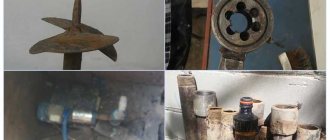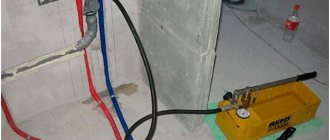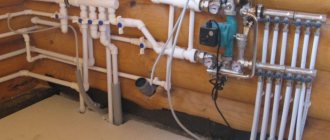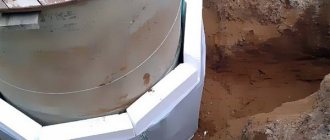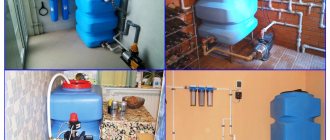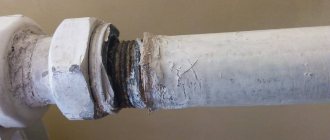How to drain water from a water supply at your dacha before winter
Don’t forget to drain the water from the summer water pipes at your summer cottage before winter. This process is simple, until the first frost.
Tips for preparing your pipeline for winter:
- The pump must be carefully removed from the well and preserved for the cold period;
- With a storage system in a container, you need to open a special drain valve.
- In places where water is consumed, you must also turn the tap valve to the open position.
- Blow out the pipeline to remove residual water (detailed instructions).
An example of drainage in the presence of a centralized water supply for a dacha
- Water supply system conservation process
- Pipe preservation
- Well conservation
- Preservation of a well at a summer cottage
- Conclusion
Making your own compressor
In order to blow out pipes for the winter, it is not necessary to purchase factory-made equipment. You can make it yourself, using available materials. For this you will need:
- take a canister, equip it with a water hose and fitting;
- the edge of the disconnected water supply is connected to the hose;
- a car pump is connected to the fitting;
- using a pump, pressure is created in the canister, which pushes water out of the pipes.
Naturally, the power of such a manual device will be insufficient, but it will be enough to blow through pipes of small diameter and length. The advantage of such a device is its independence from electricity and other power sources.
Water supply system conservation process
In order to avoid problems with the pipeline in the country, you should completely drain the water from the water supply system.
The whole point of the manipulations before leaving your own country house for the cold winter is as follows:
- disconnect the pump from the system;
- drain the liquid from it and store the unit in a warm cellar;
- pump everything out of the pipeline by opening the valves on the lower branches of the system; if there are none, then remove and blow out the pipeline elements themselves;
- dry all plumbing fixtures, it is important that no moisture remains anywhere;
- Disconnect the dishwasher and washing machine and remove the water through the small drain hole.
It is also necessary to preserve the street water supply, while pipes not dug into the ground must be thoroughly blown out with a compressor, and the fittings must be thoroughly dried. Remove the shut-off valves and remove all moisture; if removal is not possible, then simply leave the taps open and move the lever to the half-open position.
Pipe preservation
When preparing your dacha for winter, be sure to drain all appliances and preserve them. To do this, the water in the house is shut off and all electricity that powers the water heating elements is turned off and the liquid is drained from the toilet tank. It is imperative to check whether the outlet taps of the main water supply route are open.
To ensure that all moisture has been removed from the pipes, dry them using a compressor with a high air flow.
Well conservation
It is easy to properly preserve a well for the winter. After this procedure, it will be ready for work in the spring, and in winter it will not be used; access to liquid in the cold season will be completely blocked. After the water is drained from the heating units, the well is not in danger.
It is necessary to close the mouth: screw on the head that protects from precipitation and close it tightly with an airtight film
Preservation of a well at a summer cottage
In this case, you first need to isolate the entrance to the well shaft. This can be done using an insulated cap; it will reliably preserve the well and protect it from various climatic precipitations.
An excellent option for an insulated head is a log house with a flat roof made of iron sheets.
How to mothball a well
The well is preserved for the winter so that in the spring it is completely ready for use. This means that throughout the winter we will not be able to use it; access to water will be completely blocked. We have already done the main work: we drained the water from the pipeline, heater and plumbing fixtures, and removed the pump.
Now the well is not in danger, the main thing is to close the wellhead correctly: screw on the head, which will protect sheets, etc. from rain, snow, and seal it with film.
In a water supply system arranged according to all the rules, a caisson is made - it deepens the well below the freezing point, protecting it from rain and groundwater. A well with a caisson will survive any frost, the only thing is that this device is not cheap.
A FORUMHOUSE user with the nickname Lesha-Samurai has a fairly standard situation: there is a well 75 meters deep (self-flowing 10-15 m3 per hour), which will not be used in winter, and a categorical reluctance to install an expensive caisson.
According to FORUMHOUSE administrator Andrey 203, a caisson is the only reliable option in a leshy case.
Andrey 203
A caisson is needed to move the wellhead below the freezing depth of the soil.
However, a successful method of caisson-free well conservation has yet been found. Using this technology, Lesha-Samurai and his friend have been preparing their well for winter for several years now.
The algorithm is like this:
- Take 6-7 soda bottles (there should be some drink left in each bottle), shake each bottle to create pressure in them.
- Remove the head of the well and insert bottles into it.
- Put the head back.
- Pump air into the well using a car compressor through the nipple (pump for about 10 minutes). This will ensure that the water level in the well is reduced to the level of soil freezing.
- Shut off the air outlet from the well with a ball valve.
Lesha-Samurai
You can take a plug for 1, use a drill to make a hole of a suitable diameter in it and insert a nipple into it with oil.
Even if air leaves the well through elements of such a structure and the water level rises, the bottles will prevent its expansion.
How to drain water from utilities and household equipment at home for the winter
Knowledge of how to drain water from a boiler for the winter allows the owner of a private house to independently perform this simple operation if necessary, without calling specialists or spending additional material resources. The possibility of draining water from heating systems, hot water supply or cold water supply, and in-house household equipment is always provided for when designing utility lines for private houses.
Such work is carried out during planned maintenance, emergency situations and during long-term conservation in the cold season. There is no need to involve third-party specialists, except in cases of disassembling equipment under warranty; all actions for draining water are carried out in-house.
Content:
How to protect the system from freezing?
In addition to being able to drain the water, the system must be protected - at least partially - from frost. Not only a simple drain of water can save an individual water supply system from freezing - modern materials and technologies are at your service. To protect water shut-off valves from freezing of residual water, use faucets with ceramic parts and taps with rubber seals. The most resistant to water freezing are pipes, as we said above, not made of steel, but of low-density polyethylene (HDPE). Flexible plastic can withstand some increase in the volume of internal ice without collapsing, but it is still safer not to test the water supply for strength and remove all water from the water supply system before the onset of cold weather.
pipes with insulation and heating
Lay water supply pipes from the well to the residential building along the bottom of a trench dug to a frost-free depth. This guarantees complete protection of the external water supply system from any frost. The pipes must be sloping towards the water source so that the return flow occurs unhindered. Protect pipes that go to the surface - for example, a short section of pipe from a trench into a house - with a heating cable.
Draining water from the water supply system for the winter will not be difficult if this function is initially included in the design of the external and internal water supply. A technically competent solution to this problem is only possible if the design and installation of pipes for individual water supply are entrusted to professionals.
Why drain water from the heating and water supply system for the winter?
First of all, this work is carried out during conservation of systems in houses with seasonal residence. In the water supply circuits of the house, water is drained from all components, including the boiler, toilet siphons, washing machines, dishwashers, showers, filter flasks, pipes and hydraulic accumulators.
Particular attention is paid to pumps - in systems with insulated caissons, they can be left in the well after draining the water from the area above the head. In other cases, the pump is removed from the well or wells until spring. In addition, water is drained from irrigation systems or any external storage tanks.
Similar restrictions apply to heating systems - circuits with any freezing liquid coolant are drained before the owners leave for a long period.
Frosts pose a particular danger to houses with underfloor water heating: in most regions of the Russian Federation, the soil freezes in winter to 1.5 m and below, the probability of pipe rupture in a “warm field” remains high even in houses with insulated soles.
How to provide for the possibility of draining water in advance at the construction stage
To quickly drain water without stopping the operation of the entire system circuit, tees and valves are installed in front of any water heating or similar equipment. External or internal pipes should be laid with a slight slope; a tap is installed at the lowest point of the contours for emergency or scheduled drainage.
In well-designed heating systems, such taps are installed before and after each heat exchanger (Mayevsky taps) and at the lowest point of the return line leading to the boiler.
In water supply systems from wells, the drain valve is located not only at the lowest point, but also between the check valve and the hydraulic accumulator. All taps and tees are freely accessible.
Preparing the cottage for winter: draining the water
All properly designed water supply systems in country houses for seasonal residence, regardless of the material of the pipes, shut-off valves, operating pressure and location of the pump, are basically the same:
To drain all the water from the water supply, the owner of the dacha must stop the operation of this valve, then the water will return back to the well, or, if a well is used, it will drain into a special drain. Therefore, a drain valve is installed on the pipe between the check valve and the hydraulic accumulator (a valve with a long handle is placed in the well so that it can be opened and closed from the surface of the ground).
When the check valve is installed on a pipe in the house, next to the accumulator, the drain valve is installed on a parallel pipe.
Sometimes the system is not installed quite correctly, and there is no parallel pipe with a drain valve. There is no other way out - all that remains is to disassemble the water supply unit and drain it manually.
After draining the water, you need to disassemble all the filters that are installed in the system in front of and behind the hydraulic accumulator, remove the cartridges and send them for storage.
How to drain water from a boiler for the winter
In addition to preservation before winter, the need to drain water from storage heaters arises when they break down, scheduled descaling (every 2-3 years or at least once every 5 years) or when the tank is clogged with foreign impurities. The recommended method and order of draining is prescribed in the manufacturer's instructions and is taken into account when connecting pipes to the boiler.
In preparation for draining, the boiler is disconnected from the power and water supply line and left alone for a while to cool the water inside the tank.
- Soundproofing of water supply pipes in an apartment
- Characteristics of HDPE pipes for water supply
- Cold welding for plastic water supply pipes
At the same time, if necessary, tools are prepared (wrench, rubber hoses and a container for collecting water if it is not possible to drain it into the bathroom).
Next, the water is drained in one of the following ways:
- Through a safety valve. The method is valued for its simplicity - for water to flow out, just turn the valve and place a container to collect it. But due to the small cross-section of the valve opening, the process may take several hours; if it becomes clogged with scale, water may stop flowing out altogether.
- Through the hole for cold water supply. The method is considered the simplest and most convenient; when choosing it, the pipes are blocked at the inlet and outlet, a capacious container is installed under the tank, and the nut of the cold water hose is unscrewed using an adjustable wrench. To speed up and regulate the process, a hot water tap is opened at any point.
- Through both inlet and outlet openings. This method is recommended to be chosen when placing the boiler tank above a bathtub or similar tanks. When implementing it, the nut of the cold water hose is unscrewed first (with the taps completely closed!), then the hot water supply. The disadvantages of this method include difficulties in adjusting the drain speed; unscrewing all the nuts when the boiler has recently been turned off is not recommended.
How can you arrange a kitchen sink drain at your dacha?
To organize a drain at your dacha with your own hands, you need to connect a corrugation to the kitchen sink and create a water valve by bending the corrugation in an N-shape so that water always remains in it. Then connect the corrugation to a plastic pipe with a diameter of 50 mm and bring it outside the house. By the way, the kitchen sink should be equipped with a grate to prevent large food waste from falling into the drain pipe. When installing a drain on the main line between the kitchen in the country and the drainage container, it is necessary to install an intermediate siphon so that all foreign particles that are heavier than water settle at the bottom and do not fall into the container. The siphon should be equipped with an inspection window so that you can unscrew the lid and drain the water with solid particles into a bucket. This will reduce the entry of organic matter and sand into the drainage container. In this case, the volume of the barrel will be enough for a longer time, the barrel will last longer, and otherwise the rotting processes will lead to its silting.
When mixing for concreting, you need to add a spoonful of any washing powder to a bucket of water into the solution. This additive will facilitate the mixing process, improve the quality of the solution - increase its moisture resistance, strength, frost resistance, and protect it from cracking.
Then you need to take a metal barrel; if it is closed at both ends, then on one side you need to cut out the bottom using a chisel and hammer. Place the barrel with the open end down in the hole on a pre-filled bed of gravel and small crushed stone. The prepared pit for draining water at the dacha must be larger than the height of the barrel. At the other end of the barrel, you have to make one hole for the pipe, connect the barrel and the pipe taken out of the kitchen with a tee with flanges. All joints: pipes with the barrel, as well as with the outlet pipe from the sink, must be sealed.
Possible options for draining a sink in the countryside, organized by yourself, are shown in these photos:
For better resorption of waste water, you can additionally dig drainage trenches on the sides of the barrel as wide as it is, approximately 1.5-2 m long. The trenches must be filled with crushed stone and large boulders. Cover the top of the trench and barrel with a layer of earth 30 to 100 cm thick, flush with the surface of the site, and cover it with turf. On top you can plant flowers, grass and a couple of birch trees - they love water. As practice shows, if you drain a sink in your dacha in this way, the structure will last about 7-10 years.
Methods for draining water by gravity and using a pump or compressor
To drain water from the water supply circuit, it is enough to close the supply valve and open all cold water taps. At the lowest point, the water is collected in a bucket or discharged into the sewer, after which all points consuming water are sequentially checked and drained.
The main difficulties arise when working with siphons or flexible tubes of a washing machine or dishwasher: to ensure complete drying, they have to be blown out or turned over.
The last is to drain the general storage tank and, if necessary, remove the pump from the well.
An important nuance: water is drained from all equipment after disconnecting from the power supply at a temperature not lower than +5 °C. When preserving the water supply system for a long time, antifreeze or antifreeze is poured into the siphons and toilet bowl, if possible.
Gravity drainage of water from heating circuits is possible only with a certain slope of the pipes. In such cases, sequentially:
- The boiler turns off and is disconnected from power.
- The system is left alone for 1-2 hours, until the radiators and the boiler itself have cooled completely.
- The cold water tap is turned off and the first valve of the uppermost air valve is opened.
- A hose is connected to the drain valve at the lowest point of the system, draining water into a container or sewer.
- The drain valve opens, water flows until the pressure in the system completely drops.
- Other air valves open, air expels the remaining water from the gravity circuit.
- At the end, a hose is used to drain the cold water from the area where it is supplied to the boiler.
A pump connected to the lowest point of the systems and operating until the water is completely removed helps speed up the work. In houses with heated floors or pipelines without a slope, it is impossible to do without a compressor connected through manifold units or supplying air to the upper points of the circuits.
Replacing it with a vacuum cleaner (a common mistake) is not recommended; complete removal of water is ensured by devices that pump pressure up to 5 bar (but not higher than 6!).
Have you ever had to drain the water from your boiler yourself for the winter? The described procedure for draining water from a water heater provides fundamental recommendations and a general procedure for carrying out work, without focusing readers’ attention on the design features of the household appliances used.
- Repair clamp for water supply pipes
- Circulation pump for cold water supply
- Water circulation in a hot water supply system
Preservation of the well for the winter
Preservation of a well that will not be used in winter begins before the onset of frost. It is convenient to carry out operations if the check valve is installed in an accessible place immediately after the pump. Some models of submersible pumps are equipped with a built-in valve.
Conservation of the summer version of the well is carried out in the following sequence:
- Turn off the power supply.
- Open the water tap.
- Expect a drop in pressure in the system. When it reaches 0.5 atm, the automatic valve opens. It is mounted below the soil freezing level on the supply hose.
- Unscrew and remove the control unit.
If the well is equipped with an adapter, the hydraulic tank with automation is located in the house. The pipes are located below the freezing point.
To mothball the well, the pump is disconnected from the electricity and the water tap in the house is opened. When the pressure in the system drops, the valve is activated. Water from the pipeline leading into the house is drained into a well.
If the well is equipped with a caisson, the pumped storage tank and automation are located mainly in it.
Preservation is carried out in several stages:
- Electricity is cut off from the pump. Open the shut-off valve on the pipeline to the house.
- They are lowered into the caisson. Open all the taps, except the one on the riser to connect the watering of the area.
- They wait for the water to drain into the well. Open the watering tap and drain the remaining liquid.
It is not necessary to lift the pump from the well. The temperature in it is above zero, the water does not freeze. Equipment is removed and stored when thieves are feared.
We're staying for the winter
If we stay in the house, then all we need to check is the water supply to the house. We will keep the house warm anyway.
If your winter water supply was originally made from a well or borehole and the pipe is buried deep in the ground (on average 1.5 meters), there is nothing to worry about.
An exception may be a house that stands on posts or, in construction language, on a pile-screw foundation.
In this case, you need to check whether the heating cable is installed on the inlet pipe or inside it.
Eat? Just plug it into a power outlet. If it is not there, then you will have to invite a specialist to install it, since the operation is not simple.
- Coat for water supply pipes
- Causes of noise in water supply pipes
- Fittings for HDPE pipes for cold water supply
Extreme wintering
In my practice, there have been cases when people did not have enough money to bury a pipe in the winter, and their life situation forced them to spend the winter in an unfinished country house. The water supply pipe came from the well at a depth of one spade bayonet.
Usually, as long as this layer of earth froze, snow had time to fall.
Tip: if you know where your pipe goes, shovel the snow above the pipe in several layers. 40 centimeters of snow or more will no longer allow the severe frost to pass through.
At the same time, water was used frequently in the house. And at night, in severe frosts, they opened a thin stream so that there was a flow of water, so that it did not have time to freeze.
Of course, this method is extreme, but it can also be a way out of the situation.
Make sure that the place where your pipe is inserted in the house is warm. That is, if your water supply starts from the veranda, where there is access to cold, insulate this room and do not allow the temperature to drop below 10 degrees.
Perhaps this is all you need to do if you are spending the winter in a country house.
Types of water drainage systems in a private house
If you decide to drain water in a private house with your own hands, you should know that such structures are divided into several types depending on the cleaning method, the location of the storage tank, the materials used, as well as design features. So, they distinguish:
- sealed drainage pits;
- drainage;
- septic tanks.
When there is a garden or a vegetable garden on the territory, you should opt for a septic tank so that the wastewater is treated as efficiently as possible.
If the water drain in a private house is equipped correctly, it will be possible to clean the drains up to 90–95%.
- Surface sewer collections
This type of pit is suitable for summer time and is rarely found in modern areas. - Sewer network
The sewerage pipeline is mounted on the surface, observing the required slope.It is important to adhere to the basic rule: the sources of wastewater must be located above the entrance to the storage tank.
- Surface drain tank
It is installed in areas where the groundwater level is quite high.
Leaving home for the winter
The simplest, cheapest and most reliable way to protect the system from freezing is to drain the water from it. No water - no problem. But not everyone leaves home until spring; some like to come on weekends or holidays.
We come on weekends and holidays
If you are visiting the lodge for the weekend, then obviously you will need water, i.e. the option with draining the system is not suitable. To prevent the system from freezing during your absence, it is necessary to maintain a positive temperature indoors where there are water pipes or an input unit.
At the same time, the temperature should not fall below 10 degrees, so that there is a reserve for potential “cold bridges”. After all, pipes usually run behind kitchen furniture, along uninsulated walls and corners. In such places, the temperature can drop 5° below the general temperature in the house.
Is it not technically possible to maintain a positive temperature in the house or is it beyond the budget? This means that the last option left to protect the system is to drain it.
How to drain water from your home's water supply
Please check or ask the person who assembled the system, is there provision for draining water from your system? If you don’t find out from anyone, you can determine this yourself by the presence of taps on the hot water and hot water pipes at the very bottom of the system.
The easiest way to drain in this case (if it was provided during installation) is to simply open these taps.
But if the drain was not provided, you will have to use a compressor to blow air out of the system.
The compressor looks something like this:
In fact, the photo is of an industrial compressor. I just didn’t have a photo of the usual one. The most ordinary household compressor, which is used to paint the walls in the house, will do. Its size is approximately knee-length or slightly higher.
You probably had it in your closet after building your house, or you could ask a neighbor for it. In extreme cases, you will have to buy it. The cost of the unit is approximately 6 thousand rubles.
Now you need to decide whether you will drain the system yourself or call someone to help. For any of these options, the instructions below will be useful.
Compressors and their variants
Let us consider in more detail the possible options for this equipment, which differ in individual characteristics.
Here, air is compressed in piston cylinders according to the operating principle of an internal combustion engine. The advantage of this type is the simplicity of the design, its maintainability and low cost. The disadvantage is the limited operating time and noise of this process.
This type is distinguished by its small dimensions and low productivity. Its work occurs as a result of the interaction of two helices. Such equipment is suitable for blowing short-length pipes with small diameters.
The operating principle of such a device is based on the parallel rotation of two special screws. Due to low friction, this process requires little electricity and is characterized by low noise.
On the other hand, it should be noted the high productivity of this design. He is able to create sufficient pressure. Due to the complexity of the design, such products are very expensive and difficult to repair.
This type is similar to the piston design. A membrane is used instead of a piston. Its features are low efficiency and low pressure. To increase power, a small receiver is used in which compressed air is stored.
As a result of the combined work of these two elements, low-power equipment is capable of creating high pressure. This way you can significantly save your family budget. After all, to purify the water supply of a private house or cottage, there is no need to buy powerful equipment.
Procedure for draining the system
Connecting the compressor to the system
The compressor has a special pneumatic connector. It is without thread.
And this connector must be connected to an existing water supply system. To do this, you need to buy a special pneumatic fitting and connect it to your water supply system.
There is nothing complicated here. All pneumatic hoses and lines have standard ⅜" and ¼" threads. Threads in your system: ¾, ½ or ⅜.
You need to go to the hardware store in the pneumatic department, where you will find all the adapter nipples or fittings you need. Consultants will help you figure this out, just show them these photos.
We drain what can drain on its own
Now you need to turn off the water in the system or turn off the pump, open the mixer or the lowest point to drain what can drain on its own.
Be sure to drain the water from the storage water heater.
Water is drained through the cold water inlet into the boiler, through the provided drain valve, or through an emergency relief valve.
Starting the compressor
Now you need to connect to any accessible part of the system through the thread. For example, unscrew the flexible connection of the mixer, screw in a tap if it is not on the system and a pneumatic adapter (I’ll call it a socket)
Close the valve with the air inlet, connect the compressor hose to the system and turn on the compressor itself.
All taps in the system are closed. Now find the lowest tap in the system and open it. Ideally, an assistant should be at this open tap and catch water in the basin. As soon as the compressor has pumped up pressure and turned off, sharply open the valve with the air inlet and wait until all the air leaves the compressor.
Came out. Turn off the tap, let the compressor build up pressure again and repeat the operation until all the water has left the system.
Repeat the procedure
While the compressor is pumping up its tank, you can not waste time, but go open and close other water taps to let air into the system. If water no longer comes out when blowing, that means the system is empty.
Don't forget about the toilet
Now you need to unscrew and remove all the filter flasks, disassemble and drain the water from all siphons and all water seals. And also do not forget to soak up all the water from the toilet and from the toilet cistern. This is important, otherwise they will crack.
Are you sure there is no water anywhere? The system is ready for winter. I wish you success.
How to bleed the water supply system at your dacha
To be completely sure that there is no water left anywhere, the dacha water supply system will have to be purged. Even a small amount of water in winter, turning into ice, can burst a pipe.
For the winter, I always blow all the pipes with air step by step, along different lines, because when simply draining, “bags” of water still remain.
Blowing is done with a valve to which a car compressor is connected. It is screwed to the ends of pipes or flexible hoses unscrewed from the water heater.
Here's why this is done: almost always, the shut-off valves in country water supply systems are ball valves, and in their design there is a cavity where water can remain. For the same reason, you need to unscrew the shower head, shake the water out of it and put it into storage.
To summarize, preparing a country water supply system for winter includes the following mandatory steps:
Now all that remains is to remove water from the most dangerous elements of the drainage system: disassemble the siphons under the sinks, drain the water from the toilet tank and drain the water seal (for example, with a rubber bulb). In winter, instead of water, the water seal is filled with antifreeze - this way, unpleasant odors from the septic tank will not enter the house.
All that remains is to prepare the water supply and septic tank for wintering.
Water supply at home in winter: how not to freeze the system
Using a well in the cold is not the most pleasant experience
A frozen water supply system is a big problem for country house owners. Not only are they left without water, but they also have to spend large sums on purchasing new equipment and replacing pipes.
How to make a winter water supply at your dacha is a very pressing question, and the answer to it will help you avoid inconvenience and unnecessary expenses. But this problem should be solved based on whether the country house is your permanent place of residence, or is used only in the summer.
Preservation of the summer cottage water supply system
Its owners usually do not have any problems with the summer water supply at home. Because they just need to install the pump in any convenient place and connect it to the power supply.
The hose from it is lowered into a well or borehole, and a water supply pipeline to the house and site is connected to the pressure pipe. It is laid in an open way, on the surface of the earth.
However, both the pumping equipment and the water supply pipe may be damaged in frost. The water remaining in them freezes, increasing in volume, and breaks the walls of the pipes, fittings, and the insides of the pump.
If you don't drain the water, the system will have to be replaced
Therefore, the entire summer water supply system must be preserved for the winter, removing water not only from the pipes, but also from all devices and units.
Draining water from your home plumbing
Before you close your house and leave for the city for the whole winter, you need to do the following:
- Turn off the pump, drain the water from it and put it in a cellar where the air temperature does not drop to sub-zero levels. If you don’t have one, you’ll have to take it with you to your city apartment.
- Drain the water from the pipeline. The instructions provide for the installation of drain taps on them at the lowest points of each branch at the installation stage. If there are no such taps, you will have to disconnect the pipes and blow them out.
- It is also necessary to drain all sanitary fixtures: water heaters, faucets, siphons, toilet cistern, shower heads. Why are all the taps in the house opened after the water supply is disconnected, the filters and siphons under the sink and sink are removed, the shower heads are unscrewed and blown out. And the water from the toilet will either have to be pumped out with a pump, or literally scooped out or soaked with a sponge with your own hands.
- If your dacha is equipped with appliances such as a washing machine and dishwasher, take care of them too. After they have worked in drain mode, they are de-energized and the remaining liquid is released through the drain pump cover.
Advice. When purchasing equipment for your garden, choose one that will not be damaged by freezing of the small amount of water remaining in the pipes. This information should be in the instruction manual. But to be on the safe side, it is recommended to turn both the washing machine and the dishwasher upside down and leave them to spend the winter in that position.
Conservation of street water supply
It is hardly possible to find a dacha without a street water supply to supply water for irrigation, outdoor showers, and car washing. It also needs to be preserved.
For what, as in the previous case:
- Pumping units are dismantled , and empty hoses are wound up and stored in utility rooms.
- Pipes , if they are buried in the ground, are thoroughly blown out using a compressor.
- connecting fittings from exposed areas and dry them.
Advice. Polyethylene pipes for water supply will not be damaged in winter, even if there is water left in them, so it is best to install street water supply using them. But threaded fittings will become unusable. Therefore, it is advisable to install the system using welded connecting elements.
Water pipes with threaded connections must be purged
- Particular attention is paid to shut-off valves (see Valves for water supply: types, purpose, selection nuances). If it cannot be removed, the taps should be left open. Moreover, if these are ball valves, which are mainly used in such cases, then the lever, after draining the water and purging, is turned to the half-open position, 45 degrees.
Photo of an outdoor system with hoses removed and shut-off valves installed in the optimal position.
Blowing pipes for the winter
One of the important elements in the garden is the water supply.
Without watering, especially in dry summers, it is quite difficult to grow a good harvest. Mulch helps retain moisture in the soil, but this moisture must still be added to the soil. Therefore, periodic watering of plants is necessary. To organize irrigation in a garden plot, a water supply system of one of three types is made. The first type of plumbing is its absence. Along the border of the garden plot there is a common water supply system, in which there is a tap for watering the plot. The advantage of such a system is that there are no pipes on the site and they do not interfere. The downside is that you need to carry a long, heavy hose from the tap, which damages the plants and destroys the beds.
The second type of water supply is above ground. The pipes are located on the surface of the garden plot. Plus - the system is easy to install, it is easy to drain water from it for the winter. The downside is that the pipes get in the way.
The third type of water supply is underground. The pipes are located underground at a depth of more than 30 cm.
Plus, the pipes don’t get in the way. Disadvantages - more labor-intensive and expensive construction of the system, the need to remove water for the winter.
Despite the disadvantages, underground water supply is more preferable for a garden plot, especially if landscaping is done on it.
Water can be supplied to each bed and the plants can be watered on them with a hose or a drip irrigation tape can be installed.
You can also place underground hidden water points on the site, covered with lids. We connect hoses or irrigation devices to the points during watering.
When installing underground water supply, it is optimal to use polypropylene pipes that are resistant to freezing in winter. That is, if water remains in them and turns into ice, then the pipe expands under the influence of ice. And when the ice melts in the spring, it narrows, but remains intact.
However, it is better to remove water from the pipes in the fall. If only for the reason that in the spring the ice in the pipe will not melt immediately and the pipes will not be able to be used at this time. For example, in 2014, the pipes thawed only on May 5th.
There are two ways to remove water from pipes.
The first is to lay the pipes at an angle when installing the water supply system and install a tap at the lowest point to drain the water in the fall.
The second is to blow air through the pipes. A household compressor will not work here, as it has weak outgoing air pressure. Over a long pipe length, the pressure decreases greatly and water is practically not blown out of it.
To ensure guaranteed water removal, you need to connect to the system with a pipe with a diameter of 12-34 inches and high air pressure. It's easy to do it yourself. You will need: a membrane expansion tank for the heating system, fittings, a compressor for the car, a piece of hose and clamps.
The essence of blowing pipes is as follows: we pump air into the expansion tank with a compressor, then we connect the tank with a hose to the water supply system and supply air from the tank into it. At the same time, water flies out noisily from open taps. Family members and neighbors within a radius of three hundred meters must be warned about this in advance.
The expansion tank is a metal container in which a membrane is located - a rubber container. When heated, water in the heating system expands and fills the membrane. The expansion of water is restrained by air pressure, which is pumped into the gap between the membrane and the tank body. Air is pumped through a valve at the end of the tank using a car compressor.
A membrane prevents us from using the tank to blow out pipes. We unscrew the tank flange, remove the membrane and screw the flange into place. Next, screw the tap onto the flange thread. If the thread is inch, then first install adapter 1-34.
Then the tap and place an adapter on it to connect the hose. We install the same adapter on any faucet of the water supply system. Next, we put the hose on the adapters and clamp them securely using clamps. It is important! When you open the tap, air under high pressure enters the hose, and if it is not secured, it can be torn off the adapter. And this is fraught with minor injury.
So, the hose was installed and securely fastened. Next, we connect a car compressor to the tank valve and pump air into it to a pressure of 6-8 bar.
Then we open the taps in the water supply system and open the tap on the tank. Air noisily enters the pipes and blows water out of them.
When organizing purge, you need to take into account that the longer the pipes in the system, the more air will be needed to purge them. The amount of air depends on the volume of the expansion tank. The larger the tank, the larger the system can be purged with it.
If you have a pipe 5-15 meters long, then a tank with a volume of 20-30 liters will be enough. Longer lengths will require tanks of 50-100 liters. Or you can use a smaller tank, but blow out the long system in parts.
In my opinion, it is better to immediately purchase an expansion tank of 80-100 liters and permanently install it somewhere in the workshop. You will have your own compressor station providing you with high pressure air. Moreover, an ordinary automobile pump will act as a compressor. You never know where you need high pressure air! Blow out the water from the pipes, blow out the air filter, etc.
Winter water supply device
If you are going to live outside the city all year round, the water supply in a private house in winter should be arranged so that it does not fail even in the most severe frosts. To achieve this, you will have to complete a number of mandatory activities.
They are quite labor-intensive and expensive, but the cost of restoring the system after freezing will be much more expensive. Especially if equipment and pipes laid hidden behind the wall cladding freeze.
Measures for thermal insulation of the water supply system
As a rule, water is supplied to a country house from a well or borehole if it is not possible to connect to a centralized water supply. And if the water in the sources almost never freezes, since it is located at a considerable depth, then the supply system quite often suffers from frost.
To prevent this from happening, you should take care of its thermal insulation. To do this you need:
- Insulate the lid and walls of the well, and build a caisson over the well head. This is a metal, brick or plastic bunker buried in the ground, which is insulated from the inside and waterproofed from the outside.
- Pumping equipment that can function normally only at positive temperatures is installed in a warm room. This could be the basement of a house, a boiler room, or the same caisson above a well.
Note. Warm installations require surface pumps. Submersibles do not freeze while in water.
- From the source to the house, pipes are laid in a trench, the bottom of which should be below the freezing level. To be on the safe side, they can be additionally insulated with special materials.
- It is also important to ensure that the external walls are not blown through, especially at the base adjacent to the foundation. The gaps there need to be sealed. Since water pipes are usually laid along the floor along the walls, the water in them can freeze.
- Ventilation vents in the foundation must be closed during the winter.
Pipe insulation
If water supply to the dacha is necessary in winter, but the pipe system is laid in such a way that they can freeze, they must be insulated. There are several ways to do this, and the simplest is to enclose them in a thermally insulating foam shell, wrap them in mineral wool or other similar materials.
Foil polyurethane foam shell
But this method can only be considered as an auxiliary measure, or used for thermal insulation of pipes laid under the floor or in the basement, passing through the cellar or other rooms with low air temperatures.
- No amount of thermal insulation can keep you warm. It only retains heat. In severe frosts, it will not protect pipes from freezing, especially if they are open or laid above the freezing level of the soil.
- Moreover, the frozen water in them will take much longer to thaw, because the insulation will also prevent the flow of heat inside.
- Corners, tees and shut-off valves are much more difficult to insulate than a straight pipeline. And they are precisely the weakest point of the system.
Shut-off valves are the weak link of the water supply system
For reference. Different thermal insulation materials for pipes have different ability to retain heat. It is lowest for sleeves made of foamed polyethylene.
Therefore, in problem areas, pipes need to be not just insulated, but heated. To do this, use an electric heating cable or tape that is attached to the pipe. Or a heating wire inside it.
Water supply pipe heated by internal electric cable
But thermal insulation materials, when used together with a heating cable, will help you significantly reduce energy costs by reducing heat loss. They will also retain heat for some time during a power outage, which often happens in winter in countryside villages.
Heating tape and insulation guarantee the operation of the water supply system in any frost
Advice. If you do not live in the house permanently, consider a warning system in case of a power outage so that you can respond in time and prevent the pipes from freezing. In this case, it is advisable to have an alternative source of energy supply.

